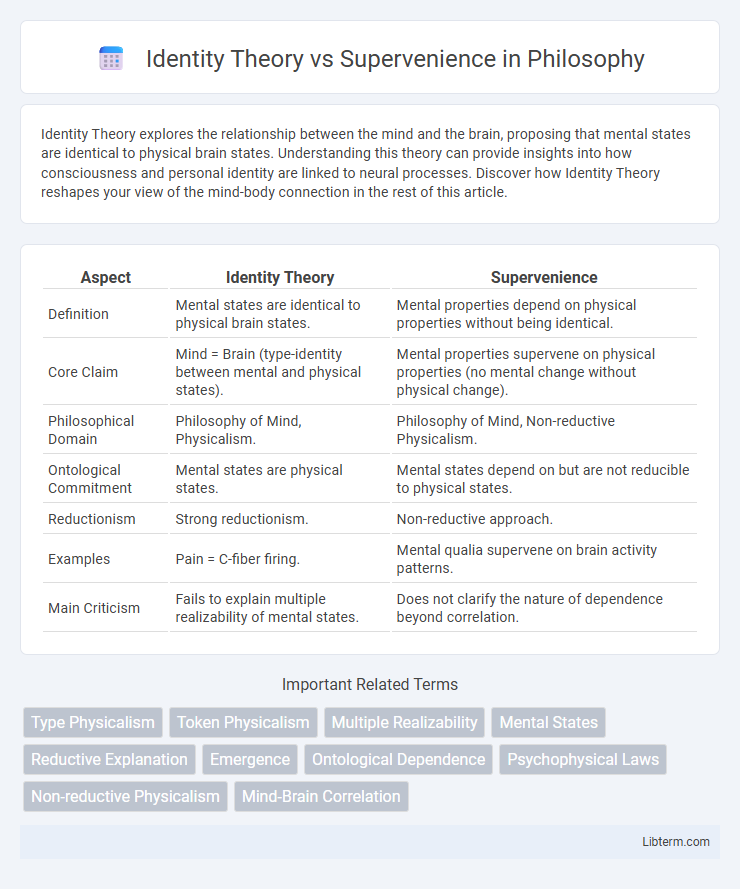Identity Theory explores the relationship between the mind and the brain, proposing that mental states are identical to physical brain states. Understanding this theory can provide insights into how consciousness and personal identity are linked to neural processes. Discover how Identity Theory reshapes your view of the mind-body connection in the rest of this article.
Table of Comparison
| Aspect | Identity Theory | Supervenience |
|---|---|---|
| Definition | Mental states are identical to physical brain states. | Mental properties depend on physical properties without being identical. |
| Core Claim | Mind = Brain (type-identity between mental and physical states). | Mental properties supervene on physical properties (no mental change without physical change). |
| Philosophical Domain | Philosophy of Mind, Physicalism. | Philosophy of Mind, Non-reductive Physicalism. |
| Ontological Commitment | Mental states are physical states. | Mental states depend on but are not reducible to physical states. |
| Reductionism | Strong reductionism. | Non-reductive approach. |
| Examples | Pain = C-fiber firing. | Mental qualia supervene on brain activity patterns. |
| Main Criticism | Fails to explain multiple realizability of mental states. | Does not clarify the nature of dependence beyond correlation. |
Introduction to Mind-Body Problem
The mind-body problem explores the relationship between mental states and physical brain states, with Identity Theory asserting that mental states are identical to brain states. Supervenience posits that mental properties depend on, or supervene upon, physical properties without reducing them to purely physical terms. These frameworks provide foundational perspectives in philosophy of mind for understanding consciousness and the dependence of mental phenomena on physical substrates.
Overview of Identity Theory
Identity Theory posits that mental states are identical to physical brain states, suggesting a one-to-one correspondence between psychological experiences and neural processes. This theory implies that every type of mental event directly corresponds to a specific type of brain activity, emphasizing a reductionist view of the mind-body relationship. It contrasts with supervenience, which holds that mental states depend on, but are not reducible to, physical states, allowing for multiple realizability across different physical substrates.
Key Arguments for Identity Theory
Identity Theory asserts that mental states are identical to physical brain states, emphasizing a one-to-one correspondence between the two. Key arguments include the explanatory power of neuroscientific evidence showing specific neural correlates for mental experiences and the principle of parsimony, which favors simpler ontological commitments. This theory also addresses the locality of experiences, arguing that mental phenomena are not separate substances but are reducible to brain activity.
Introduction to Supervenience
Supervenience is a metaphysical concept describing a dependency relation where higher-level properties depend on, yet are not reducible to, lower-level physical states. This contrasts with Identity Theory, which asserts a direct equivalence between mental states and brain states. Understanding supervenience clarifies how mental phenomena can be systematically linked to physical substrates without requiring strict identity.
Key Principles of Supervenience
Supervenience posits that mental states depend systematically on physical states, where any change in mental properties necessitates a change in underlying physical properties, emphasizing a non-reductive relationship. Unlike Identity Theory, which asserts a strict one-to-one correspondence between mental and brain states, Supervenience allows for multiple physical realizations of the same mental property, highlighting property dependency without ontological reduction. This principle supports the idea that while mental properties cannot emerge independently, they do not simply reduce to physical properties, maintaining a distinct but dependent status.
Major Differences Between Identity Theory and Supervenience
Identity Theory asserts that mental states are identical to physical brain states, emphasizing a one-to-one correspondence between mind and matter, while Supervenience posits that mental properties depend on physical properties without being reducible to them. Identity Theory supports a strict physicalist ontology, limiting mental states to brain processes, whereas Supervenience allows for multiple realizability, where different physical states can underlie the same mental state. The major difference lies in reductionism; Identity Theory advocates mental-physical identity, whereas Supervenience maintains a non-reductive dependence relation.
Philosophical Implications of Both Theories
Identity Theory asserts that mental states are identical to physical brain states, implying a monistic ontology that challenges dualistic notions of mind and body, thereby simplifying the metaphysical framework of consciousness. Supervenience posits that mental properties depend on and are determined by physical states without being reducible to them, preserving a form of non-reductive physicalism that addresses the complexity of mental causation. Philosophically, Identity Theory favors ontological parsimony but struggles with explaining subjective experience, while Supervenience accommodates mental autonomy but raises questions about the nature of dependence and emergence.
Criticisms and Challenges
Identity Theory faces criticism for its inability to account for multiple realizability, where the same mental state can be instantiated by different physical states across species. Supervenience struggles with explanatory gaps, as it asserts a correlation between mental and physical states without specifying causal mechanisms. Both theories confront challenges in addressing the subjective quality of conscious experiences and the problem of mental causation.
Contemporary Perspectives and Debates
Contemporary perspectives on Identity Theory emphasize the strict correlation between mental states and physical brain states, advocating for type-identity or token-identity depending on the approach. In contrast, Supervenience posits that mental properties depend on physical properties without necessitating a one-to-one identity, allowing for multiple realizability across different physical substrates. Current debates revolve around whether supervenience adequately addresses the explanatory gap and how identity theorists respond to challenges from functionalism and non-reductive physicalism.
Conclusion: Evaluating the Theories
Identity Theory asserts a direct correlation between mental states and brain states, emphasizing a one-to-one correspondence that supports physicalism. Supervenience Theory offers a nuanced approach, suggesting mental properties depend on physical substrates without strict identity, allowing for multiple realizability. Evaluating these theories highlights Identity Theory's strength in explanatory clarity against Supervenience's flexibility in accommodating complex mental phenomena.
Identity Theory Infographic

 libterm.com
libterm.com